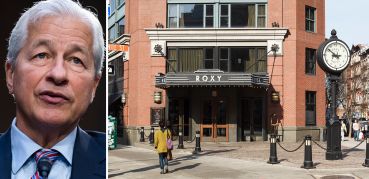Manhattan Bounces Back in Global International CRE Activity Amid Challenges
The Big Apple returns as leading market for global real estate investors despite economic uncertainties and increased U.S. competition.
By Andrew Coen October 31, 2022 3:06 pm
reprints
Manhattan is back in the New York groove in terms of being the top U.S. commercial real estate market for international investors a year after falling to third place and despite headwinds in the office market..
A recent report from MSCI Real Assets showed that Manhattan was once again in the No. 1 spot in foreign CRE international activity with a 279 percent increase in the first six months of 2022 compared with the prior four quarters. In 2021, the Big Apple slipped to third place behind Atlanta and Boston as investors grappled with concerns about the future of office properties amid rising vacancies and remote work trends.
Those uncertainties remain, but a number of international players have planted flags in New York this year. Manhattan cross-border CRE volume was at $1.14 billion in the first half of 2022, largely from Asia and Europe, according to MSCI. Last year’s total global activity for Manhattan numbered $3.78 billion, with a big uptick in the second half of the year as the economy opened up more from pandemic restrictions.
“It’s not what it was in 2015, when people were paying the top price for something, but cross-border buyers came back in Manhattan more so than other markets,” said Jim Costello, a senior vice president at MSCI. “Manhattan, despite some challenges and questions about return to office and what happens next, is still a market where you have bigger deals on offer.”
Costello noted that much of the international activity in Manhattan this year has centered around the multifamily market, including Korean firm Eugene Asset Management’s acquisition of the 20-story 251-257 West 94th Street for $266 million from Related Companies in the second quarter. But there were still some big office acquisitions. These included Australia’s Macquarie Asset Management buying 375 West Broadway, a Class B building in SoHo built in 1900.
Part of the global investment away from the New York has stemmed, Costello said, from heavy interest in the industrial sector, which Manhattan lacks. This opens doors to other markets, especially in areas of the Southern U.S. such as Dallas.
International investments in New York slowed in the third quarter of 2022 as the debt markets began to freeze up on the heels of the Federal Reserve beginning its hawkish strategy of raising interest rate hikes to combat inflation. There were still some large deals in that quarter, though, including Spain-based Ponte Gadea purchasing a 483-unit multifamily property at 114 Fulton Street in the Financial District for $487.5 million in September.
U.K.-based 99c LLC also made its presence felt in Manhattan with a $252 million all-cash acquisition from Vanbarton Group of 175 Water Street, a vacant office property that was the former headquarters of AIG, in a possible repositioning opportunity.
Janice Stanton, executive managing director in the capital markets group at Cushman & Wakefield (CWK), said that international families seizing opportunities to jump into the Big Apple at a discount have driven a lot of global flow into New York City CRE this year. Still, the current dislocation in the debt markets is giving many investors pause. Stanton said the remaining uncertainty with how hybrid working trends will affect future office space needs is another factor that is weighing on investment decisions, prompting some to consider other U.S. markets in the Sun Belt.
“New York will always be New York, but the higher growth markets of the Southeast and Southwest are very highly competitive with capital headed towards New York,” said Stanton, who has had 65 face-to-face meetings with international investors since the summer in Seoul, Munich, Chile, Singapore, Brazil and the United Kingdom. “A decade ago someone would say, ‘I want to buy in New York, D.C., Boston and San Francisco,’ and right now the global investors will say, ‘I really love the Southeast and Southwest because it’s a very high growth rate; and for the right thing we also like New York and Boston.’ So it doesn’t dominate the way it used to dominate.”
Value opportunities in New York remain attractive to global CRE investors, but the increased challenges to obtain debt financing for deals have proved to be a major headwind since investors want to avoid a negative leverage scenario, according to Stanton. She noted that many international players think the U.S. will overall outperform Western Europe and the U.K. because of the unrest with Russia’s war against Ukraine, but stressed that employers have had more of the upper hand in getting workers back to the office across the pond. That is another important consideration with where to park money.
New York City office occupancy on a given weekday has hovered near 50 percent since Labor Day, according to Kastle Systems, a security firm that tracks office entry swipes. That’s a big increase from the summer but still well below pre-pandemic levels, which were in the upper 70 percent range. New York office occupancy now is way ahead of San Francisco, but lags Sun Belt markets like Austin, Texas, where about two-thirds of offices are regularly used, aided in part during the pandemic by more options to drive to work.
“If you drive to your office and you’re not commuting tightly with someone on a subway, you tend to have a little bit better occupancy performance,” Stanton said.
The office sector remains the dominant driver in global CRE investments, mostly with properties clustered in Manhattan, but Stanton said of late more investors are showing interest in multifamily transactions in the outer boroughs, especially Brooklyn.
MSCI is slated to release its third-quarter data on cross-border investments in November, which Costello said will reflect some of the new challenges the CRE industry is facing with higher interest rates. He stressed, though, that it is unclear yet how a slowdown in lending will affect cross-border activity over the near term.
“On the one hand these groups aren’t going to be needing as much leverage as others,” Costello said, comparing international players to domestic investors. “But knowing that other bidders are out of the market because they need leverage to get a deal done, maybe they decide they don’t have to be as aggressive and will take a more wait-and-see approach to see if things pull back a bit.”


